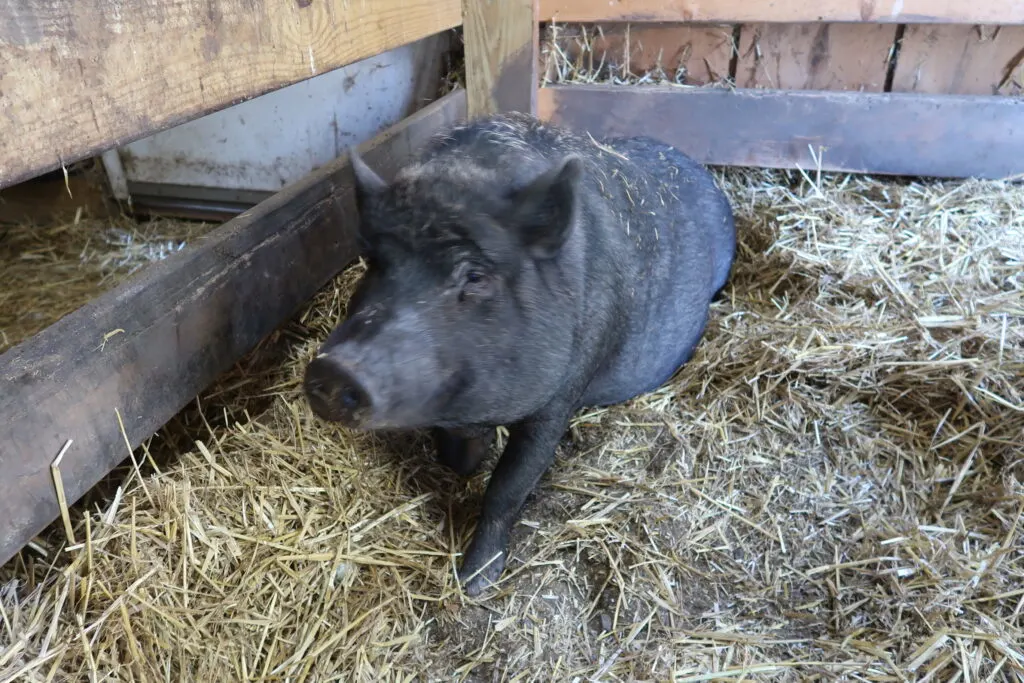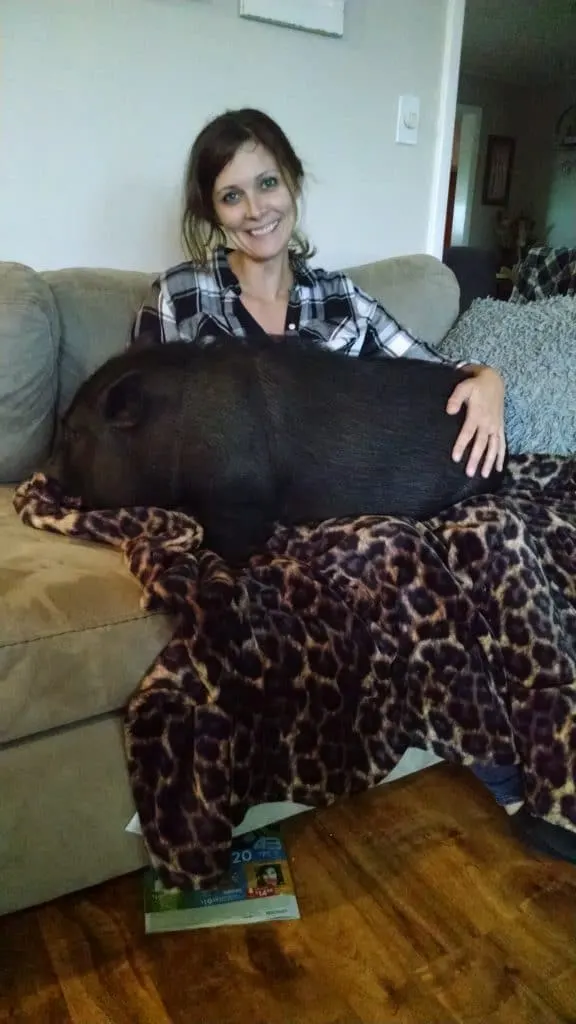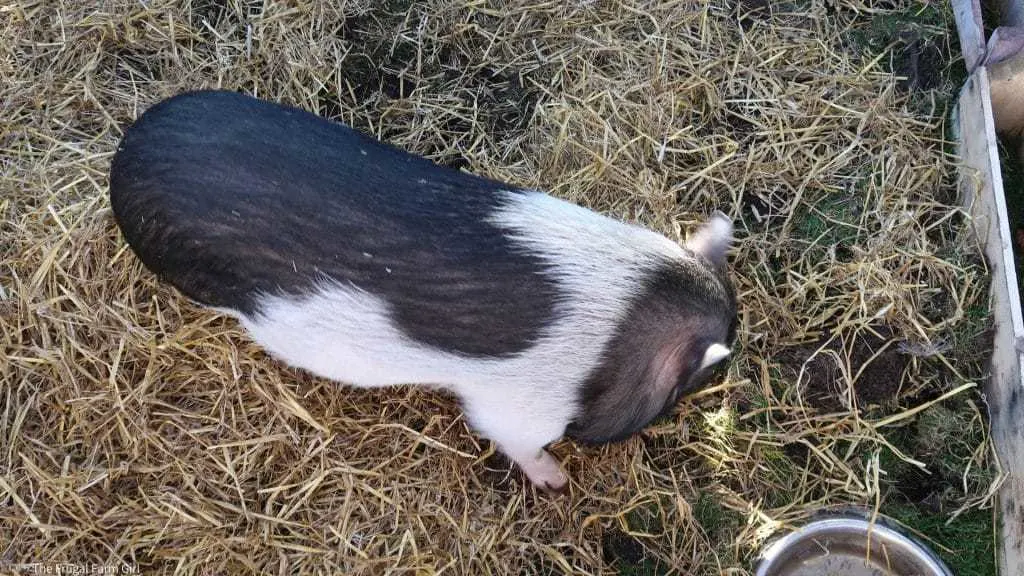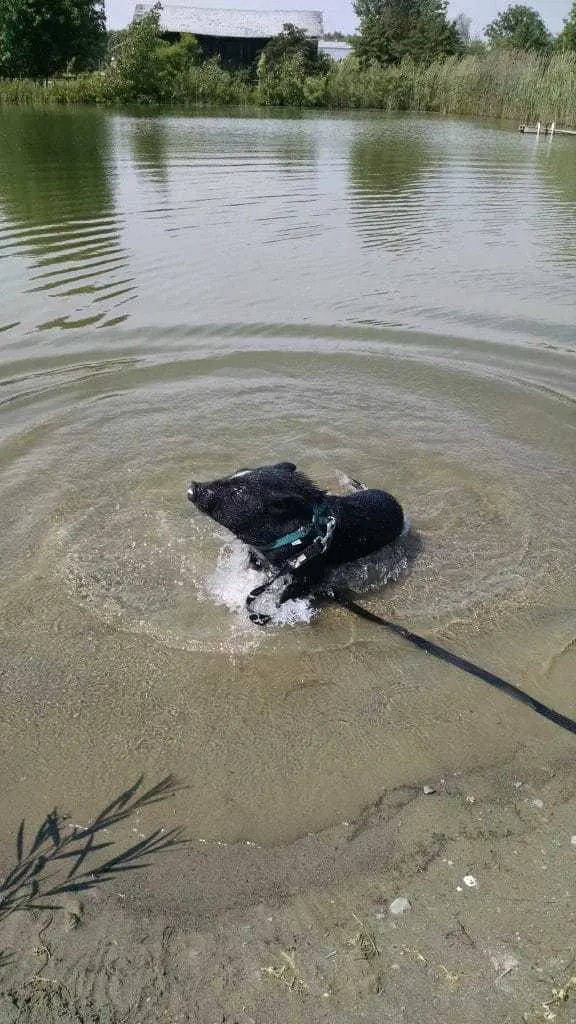Potbelly pigs, often dubbed as the perfect little porkers and the darlings of homesteads, can be incredibly endearing pets. They are charming and intelligent animals with soulful eyes, making them irresistible to animal lovers.
If you’ve been mulling over adding a potbelly pig to your family, you’ve probably wondered about the costs of this unusual yet delightful companion.
After having my three pet potbellied pigs for six years, I can tell you that they are the easiest animals to take care of on our homestead. I got a registered Juliana piglet from an amazing breeder near us. She is still our smallest pig.

Understanding the full range of expenses associated with potbelly pig ownership is essential for making an informed decision. From the initial purchase of your piggy friend to the unexpected costs that may arise, we’ve got you covered.
Potbelly pigs make wonderful pets for many reasons. They are smaller than traditional farm pigs, making them a great option for those who may not have as much space or resources.
While some people refer to them as “teacup” pigs or “miniature” pigs, the reality is that potbellied pigs can range greatly in size and can even grow up to 200 pounds! It’s important to understand the full potential size of your pig when considering ownership.

If you are set on getting a potbellied pig as a pet, finding a reputable breeder is crucial. This will ensure that you are getting a healthy and well-cared-for piglet. Beware of breeders advertising “micro” pigs or “teacup” pigs, as these terms are often used to deceive potential buyers.
A reputable breeder will also be able to provide you with important information about the pig’s parents and lineage, giving you a better idea of what to expect in terms of size and behavior.
While potbellied pigs are generally known for their intelligence and social nature, it’s important to remember that they are still animals and require proper care and attention. They can make great companions for pet owners with the time and resources to dedicate to them.
It’s also worth noting that potbellied pigs may not be legal in all areas, so it’s important to check with your local laws before bringing one home.

Once you’ve found a reputable breeder and brought your piglet home, providing them with a suitable living environment is important. This includes a proper shelter and access to outdoor space for rooting and exploring. It’s also important to provide them with a balanced diet, which may include commercial pig feed and fresh fruits and vegetables.
Potbelly pigs can also make great indoor pets, but it’s important to remember that they are still pigs and may not be fully house-trained. It’s important to have a designated potty area for them and to work on training them from a young age. They also require regular grooming, including hoof trimming and brushing.
The Initial Cost
The initial cost is the first expense to consider when you’re looking to bring home a potbelly pig. Baby pigs, known as piglets, are the most common choice for new owners, and their prices vary greatly.
I found my first potbellied pig on Craigslist for $100 in 2016. I saw the mom and dad at the farm we got him from, which was helpful regarding size. I bought little puppy-size bowls for his food and water and used an old under-the-bed storage container for his litter box. I share all the details on the first day we brought him home here.
Let’s look at the typical cost of bringing home a potbellied pig.
- Non-registered potbelly pig- $100-$200.
- Registered potbelly pig- $300-$500+.
- One 50 lb. bag of Purina Pig and Sow feed $22
- Rubber Food bowl – $10
- Rubber Water Bowl– $10
- Pig Harness -$22
Total cost, taking the lowest amount shown above for a nonregistered mini pig: $164
Total cost, taking the lowest amount shown above for a registered mini pig: $364
As far as costs throughout the year, we only spend money on Ivermectin for worming twice a year, as well as pig food. We trim the nails ourselves and haven’t needed to trim our male potbelly pig’s tusks yet. He’s six.
We do buy lots of straw for the pigs in winter and for our other animals, but if you keep them outside, you’ll need lots of straw.

House training my first mini pig was easier than potty training a dog! They are smart, and consistent actions help these pet pigs learn quickly. Bentley learned to use the litter box on the first day we brought him home! We brought him home when he was eight weeks old.
In addition to proper care, it’s important to socialize your potbellied pig from a young age. This means exposing them to different people and animals and providing them with mental stimulation through activities and training. With proper socialization, potbellied pigs can make friendly and affectionate companions.
Otherwise these young pigs become aggressive with other family members and protective of their owner. I had all family members take turns feeding Bently while he lived in our house.
If you’re considering adding a potbellied pig to your family, it’s important to do thorough research and be prepared for the responsibilities that come with being a pig parent. This includes finding a reputable breeder or adopting from a rescue group dedicated to tiny pigs. We got our second potbelly pig from an animal rescue, and she’s amazing. The adoption fee for her was only $60.

She came up to date with all her vaccines and was spayed.
It is sad how many mini pigs end up at the shelter. Before you bring one home, really consider your lifelong commitment to it.
Proper care and maintenance of your potbellied pig will also require regular hoof trimming, veterinary check-ups and addressing any health problems that may arise. Staying on top of these tasks is important to ensure your pig’s well-being.
Finding a local vet is a little trickier with potbellied pigs. We pretty much do most vaccines and hoof trimming ourselves. When in doubt, we do have a farm vet who will come to our house and take care of the pigs. It’s helpful to have that figured out first because in case of an emergency, you don’t want to scramble to find someone.

Social interaction is also crucial for potbellied pigs,and if your pig continues to be aggressive, the best thing to do is have another pig as a companion. As exotic animals, it’s important to educate yourself on their behaviors and needs to provide a happy and healthy environment.
Potbellied pigs may be small in size, but they require just as much care and attention as any other pet. As responsible pig parents, it’s important to prioritize their physical and mental well-being through proper diet, socialization, grooming, and veterinary care.
With proper care and love, your potbellied pig will surely become a beloved companion and bring unique joy to your life. Additionally, always be mindful of the laws and regulations regarding owning a potbellied pig in your local area.
Some places may have restrictions on owning exotic animals, so it’s important to check with your city or county before bringing home your new pet. Responsible ownership also includes proper housing and containment for your pig, as well as keeping up with any necessary licenses or permits.

Tips for Owning a Potbellied Pig
- Be sure to provide a balanced and nutritious diet for your potbellied pig, including fresh fruits and vegetables.
- Regularly groom your pig to keep their coat clean and healthy.
- Potty train your pig to avoid any accidents in the house or yard.
- Keep your pig mentally stimulated with toys and activities to prevent boredom.
- Be prepared for potential health issues and have a trusted veterinarian who is familiar with potbellied pigs.
- Socialize and train your pig from an early age to ensure they are well-behaved and comfortable around humans.
- Provide adequate space for your pig to roam, explore, and exercise.
- Consider getting a companion for your pig, as they are social animals and enjoy having a friend.
- Keep an eye on your pig’s weight and adjust their diet accordingly to prevent obesity.
- Always be patient, understanding, and loving towards your potbellied pig.
Breeder Reputation
Highly reputable breeders who prioritize the health and well-being of their animals may charge more for their piglets. However, investing in a pig from a good breeder can save you money in the long run by reducing the risk of genetic health issues.
Please DO NOT believe that a pig will stay small because the breeder says it will. Sometimes, breeders underfeed the pigs. Pigs take 4-5 years to fully grow.
- Why I Sold My Kune Kune Pig – Our Experience & Lessons Learned
- How Much Do Potbelly Pigs Cost- Your Guide to Owning Pigs
- The Best Fencing for Your Pigs You Need Now
- How Big Do Potbelly Pigs Get + Mini Pig Facts
- Tips to Calm a Mini Pig: A Beginner’s Guide to Raising Happy and Relaxed Piglets
Age and Color
Younger potbelly pigs, especially those with unique coloring or other desirable traits, will typically be more expensive than older pigs or those with standard coloration.
While the initial cost may be higher for a younger, more attractive pig, older pigs may already be spayed or neutered, saving you the cost of this procedure.
Influencing Factors
Other variables that can affect initial costs include the location of the sale, local market demand, and the current popularity of potbelly pigs as pets in your area.

Ongoing Expenses
Potbelly pigs require a substantial investment of time and resources throughout their lives. The ongoing expenses include various things from food to basic healthcare needs.
Feeding and Dietary Needs
Pigs need a balanced diet high in fiber. Pig pellets, vegetables, fruits, and occasional treats can achieve this. The dietary cost can vary, but expect to spend a significant amount each month to keep your pig healthy and happy.
Health Care
Annual veterinary check-ups are a must for potbelly pigs and should be factored into your budget. Vaccines, deworming, and flea treatments are common expenses, as well as the costs associated with unforeseen health issues.
Equipment and Supplies
You’ll need to invest in supplies like a sturdy shelter, a high-quality water trough, and a feeding dish. Additionally, grooming kits, toys, and bedding materials are necessary to maintain your pig’s well-being.

Unexpected Costs
Even with the most diligent care, there are always unexpected events that could lead to additional expenses.
Unforeseen Medical Bills
Accidents and illnesses can happen, and the costs of treatments can add up quickly. It’s important to have an emergency fund set aside specifically for your pig’s needs.
Behavioral Training
Pigs, like any pet, need to be trained. Behavioral classes and proper handling techniques might become necessary, especially when dealing with a stubborn pig.

Ways to Save
While the costs of potbelly pig ownership can be high, there are certainly ways to save money without sacrificing your pet’s well-being.
Economical Feed Options
Buying feed in bulk can often result in significant savings. Some owners also opt for mixing their own feed based on veterinarian advice to save on costs.
Preventative Health Measures
Keeping your pig’s living area clean and safe and staying up-to-date with vaccinations and check-ups can prevent costly health issues down the road.
The investment in a potbelly pig goes beyond the initial purchase price and touches on various aspects of your life, from finances to time management. Be sure to carefully assess your readiness to commit to the responsibility of pig ownership. It’s an adventure that can bring immense joy but requires thoughtful planning and preparedness.
Ready to take the leap? Remember to research thoroughly, seek advice from experienced pig owners, and budget wisely. Responsible pet ownership ensures your potbelly pig has a happy, healthy, and fulfilled life in your care.
For more information on potbelly pig care and ownership, follow our blog for updated tips and insights. Together, we can create a community of knowledgeable and loving potbelly pig owners. Happy pig parenting!
